
Taints are basic defilements of the mind. Pali term for Taints is Asava. The purpose of this post is to further examine the meaning of this term and to understand clearly how they work in relation to the workings of the mind. Asava is also frequently translated as fermentations in the sutta. Other terms includes effluents, pollutants or cankers. They are also defined as In-flows, influxes, influences, corruption's, intoxicant biases.
There are three types of taints according to the sutta. Taints of sensuality (kāmāsava), Taints of becoming (bhavāsava) and taints of ignorance (avijjāsava). Abhidhamma adds another taint. This is called the taint of views (ditthāsava).
The fundamental taint of all these is the taint of ignorance (avijjāsava). This is confirmed in Sammaditthi sutta, when Ven. Sariputta said that ignorance was the cause of all taints. In this sutta he states "With the arising of ignorance there is the arising of the taints. With the cessation of ignorance there is the cessation of the taints." This is also confirmed in the Nibbedhika Sutta.*(see below)
The meaning of “Asava” according to Bhikkhu Bodhi: “Savathi” means flow, “A(h)” is the prefix interpreted as flow in (influents) or out (effluents). Some say that taints flow in whereas others say that taints flow out. There is yet another group that say taints can both flow in and out. This models supports that theory (explained later). However all agree that taints are basic defilements of the mind.
In this post we will try to examine how taints work in relation to the workings of the mind. We will also try to understand why different interpretations such as flowing in and flowing out were given by different authors.
Other related words:
Khīnāsava (also called anāsava or nirāsava) is the one whose taints are destroyed. It is another name given for an Arahant or fully enlighten one. When one attains Arahantship it is frequently called āsavakkhaya, the one who has destructed all taints. It is also known as one of the three fold knowledges* * (āsavānaŋ khaya nana) to complete this path. This is a recurrent theme you find when you read Sutta*** and Theragatha, the verses of the elder monks.
Sāsava: this means asava or taints are is still present. This is the opposite of Khīnāsava.
In this post we will examine the taints of sensuality which we usually deal with in day to day life. I have taken here the eye as the sense organ and a piece of cake as the sense object.
Taints are basically flow of information from the object to the mind through the senses (See Figure 1 below).

Figure 1
The flow will depend on our craving. More craving you have for the object more taints will arrive at the mind. Here is a simplified model of what happens (See Figure 2 below).
Figure 2
When an object is cognized by the eye we see the object (Figre 2-1). If it is pleasing to the eye we then want to look at the object as craving arises (Figure 2-2). The flow of information that is brought into the mind about the object becomes the taints. These are basically memory stored that can be retrieved. As we keep looking this gives rise to more craving and therefore this will give rise to more taints (Figure 2-3). Eventually we "lock on" or cling to the object with craving (Figure 2-4). How we cling to things were discussed in a previous post.
The mind is hungry and is always looking to feed on the taints. If it is an unpleasant object we crave for that in a different way. This time we crave to get rid of it. This too will give rise to unpleasant thoughts. These are continuous influx of thoughts both pleasant and unpleasant. They can be also considered as food of mental volition that keeps feeding the mind.
If you look into this in more detail using the mind works model you can see what really happens (Figure 3-5). When the eye meet the object, eye consciousness arises. Meeting of the eye, the object and the eye consciousness, the contact arises. Now this information appears to flow out of the senses into the mind. these are stored as memory of previous events. These can be triggered by new information coming in and will add to the out flow of thoughts. This may keep the attention on the object you desire causing more information and memories stored for future use. This may be why some scholars interpret that taints flow out. (Figure 5).
In the first few cognitive series gives us information about the perception, feeling and previous memory about the object (Figure 3). How cognitive series work was discussed in detail in previous post called "Are we really "multi tasking"or is it just another sophisticated function of the mind?"
The number of thoughts are amplified (mental proliferation) as we keep the attention on the object. These thoughts are brought back to the mind as influxes or in-flows. All these thoughts are tainted with craving in the background of ignorance. These become the taints of the mind. All these thoughts make kamma depending on which ones you cling on to it will determine your future becoming (Bhava) and hence rebirth (Please see the post on rebirth and dependent origination). This is the diversity of taints discussed in Nibbedhika sutta (*See the notes at the end of this post).
 Figure 3: Basic cognitive process that involves seeing an object. Although these figures (Figure 3,4 and 5) shows multiple cognitive series it is important to note that only one track is generated at a given time, triggered at a very rapid speed.
Figure 3: Basic cognitive process that involves seeing an object. Although these figures (Figure 3,4 and 5) shows multiple cognitive series it is important to note that only one track is generated at a given time, triggered at a very rapid speed.  Figure 4: When we look at the object there is intention and desire present. More craving and more taints arise. There is a proliferation of the cognitive tracks here. The inflow of thoughts to the mind with craving becomes the taints of the mind.
Figure 4: When we look at the object there is intention and desire present. More craving and more taints arise. There is a proliferation of the cognitive tracks here. The inflow of thoughts to the mind with craving becomes the taints of the mind.
Figure 5: If we keep interacting with the object further, more craving arises as other senses too may join in like smell, taste, sound, feeling, etc. This is specially true with food. The cognitive tracts from these senses are not shown in this figure to keep the diagram less busy. However the places where craving arises is shown in a red stars. The multiple green arrows shows taints flowing out of the mind as mind-consciousness (i.e., as ideas). Here there is much more craving hence much more taints are generated. This is called clinging to the object.
Asava are therefore better defined as flows of thoughts in and out of the mind triggered by previous memories in the presence of carving and ignorance.
The translation of the Asava as Taints or Fermentations alone may not be enough to give the true meaning of Asava.
Kinasawa are inflows of thoughts into the mind devoided of craving and ignorance. This is the thought process of an Arahant. An Arahant has destroyed all craving and ignorance there are no more taints. The thoughts of an Arahant do not make kamma for a future birth (no more Bhava/Becoming) as there is no more craving and clinging. All this happen in the absence of ignorance.
In Samadhi sutta Buddha says "As for the individual who has attained both internal tranquillity of awareness & insight into phenomena through heightened discernment, his duty is to make an effort in establishing those very same skillful qualities to a higher degree for the ending of the taints."
This is called abandoning taints by developing (bhāvanā pahātabbā) (Please see Sabbasava sutta below).
Internal tranquility through breath meditation will prevent taints of sensuality from arising as there is no room for the senses to be engaged in other activities other than the perception, feeling and directed evaluation (applied and sustained thoughts) of breath. This happen specially after mindfulness of the breath becomes immersed in the body. The metaphor Buddha gave here was the six animals tied to a strong pole in Chappana sutta. In Jhana states too taints of sensuality are abandoned. However taints of becoming may still exists.
The difference in insight meditation is that thoughts arrive in the mind from six senses but the mind does not give any value to them as seeing them as impermanent, suffering, and not-self. This will not allow thoughts to proliferate any further. Craving does not arise here. The thoughts die in the mind itself without mental proliferations (papañca) generating taints. This method of training finally abandons all taints.
If one expects to abandon taints without developing, in Nava sutta Buddha says "it is like a hen expecting the chicks to break through the eggs without incubating them rightly."
However one who dwells devoting himself to development (bhāvanā pahātabbā) will know when the taints are abandoned, even though he cannot say how much taints are abandoned from day to day. Buddha says it is "just as when a carpenter or carpenter's apprentice sees the marks of his fingers or thumb on the handle of his adze but does not know, 'Today my adze handle wore down this much, or yesterday it wore down that much, or the day before yesterday it wore down this much,'' still he knows it is worn through when it is worn through" (Nava sutta).
There is a sutta that discusses in detail how to abandon all taints. It is called the Sabbasava sutta. In this sutta Buddha talks about seven methods of restraining/abandoning taints. The key to this is Yoniso manasikara (appropriate attention/reflection, wise attention/reflection).
The noble disciple (the one who has heard, skilled and disciplined in Dhamma) will abandon taints by Yoniso manasikara or reflecting appropriately. The taints (thoughts that proliferate with craving/aversion as discussed above) will subside, new taints will not arise. The last method will completely abandon all taints as discussed above.
1. Seeing (dassanā pahātabbā) Does not attend to what is unfit for attention, attends to what is fit for attention...
2. Restraining (saṃvarā pahātabbā) - Restraining the six senses...
3. Using (paṭisevanā pahātabbā) -The use robes, alms-food, lodging, medicinal requisites...
4. Tolerating (adhivāsanā pahātabbā) - Endures cold, heat, hunger, & thirst...
5. Avoiding (parivajjanā pahātabbā) - Avoids certain animals, certain places, certain people..
6. Destroying (vinodanā pahātabbā) - Thoughts of sensuality, ill will and cruelty...
7. Developing (bhāvanā pahātabbā) - Develops mindfulness as a factor for Awakening dependent on seclusion... dispassion... cessation, resulting in letting go... (mindfulness meditaion/ insight practice).
There is a discussion on this sutta by Bhikkhu Bodhi. The links are give below. First you need to download the MP3 file and then listen.
4. Eliminating the taints
On 2004.08.31
MN 2: Sabbāsava Sutta — All the Taints
table: Fetters, Latent Tendencies, and Influxes
MN 2: Sabbāsava Sutta — All the Taints
table: Fetters, Latent Tendencies, and Influxes
On 2004.09.07
MN 2: Sabbāsava Sutta —All the Taints
(continued)
MN 2: Sabbāsava Sutta —All the Taints
(continued)
On 2004.09.14
MN 2: Sabbāsava Sutta —All the Taints
(continued)
MN 2: Sabbāsava Sutta —All the Taints
(continued)
On 2004.09.21
MN 2: Sabbāsava Sutta —All the Taints
(continued)
MN 2: Sabbāsava Sutta —All the Taints
(continued)
Reference for audio mp3- A Systematic Study of the Majjhima Nikaya By Bhikkhu Bodhi
*Notes: Extract from Nibbedhika Sutta (Fermentations are used here for Asava instead of taints):
..."There are these three kinds of fermentations: the fermentation of sensuality, the fermentation of becoming, the fermentation of ignorance.
"And what is the cause by which fermentations comes into play? Ignorance is the cause by which fermentations comes into play.
"And what is the diversity in fermentations? There are fermentations that lead to hell, those that lead to the animal womb, those that lead to the realm of the hungry shades, those that lead to the human world, those that lead to the world of the devas. This is called the diversity in fermentations.
"And what is the result of fermentations? One who is immersed in ignorance produces a corresponding state of existence, on the side of merit or demerit. This is called the result of fermentations.
"And what is the cessation of fermentations? From the cessation of ignorance is the cessation of fermentations; and just this noble eightfold path — right view, right resolve, right speech, right action, right livelihood, right effort, right mindfulness, right concentration — is the way leading to the cessation of fermentations...
Nibbedhika Sutta: translated from the Pali by Thanissaro Bhikkhu-
* * Threefold knowledges:Knowledge of past lives, knowledge of the passing away and rebirth of living beings, and knowledge of the ending of taints (fermentations).
***To read more sutta on fermentation, taints or effluents please click on the hyperlinked words below:
2. Taints
3. Effluents
I apologize for the variation in the font throughout this post.


















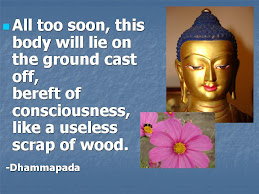

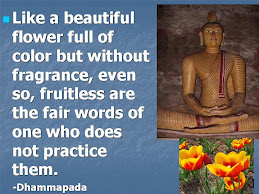




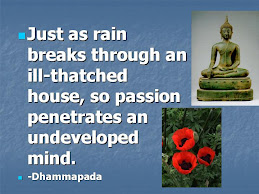


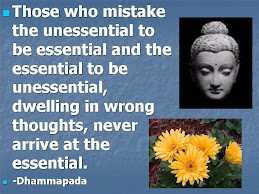
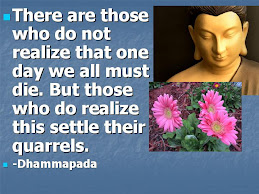





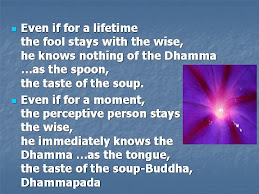



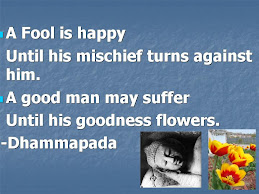
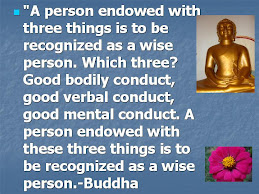

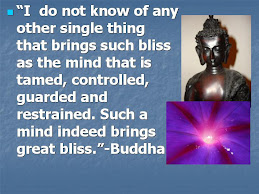
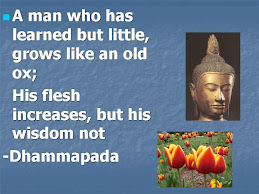
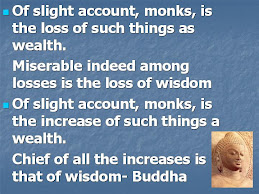
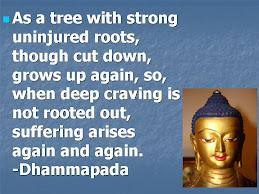
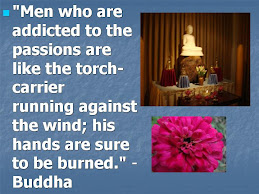



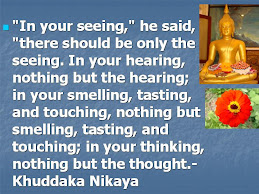





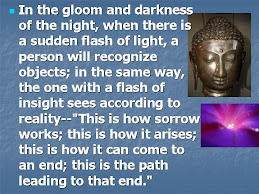
















2 comments:
Dear Sir,
Is the following a fair interpretion?:
With Ignorance (not relating to sensual and mental experience as they really are) as their cause and support, the asavas arise and are supported. These asava act similiar to a lens that affects our intrepretion of both sensual and mental information. This inaccurate, ignorance ridden intrepretion further create and support ignorance and hence Dukkha. By developing mindfullness we "step back" from the lens of the asava and can both see experience through the asava and "around" them. By seeing the disparity between experience through the asava and "around" we gain insight. It is with this insight that we can diminish or destroy the lens of the asava by removing their cause and support - Ignorance.
Often , I intrepret the path as a methodology to develop a relationship with our experience that is free of misinterpretation. Being free of misinterpretation we are then free to choose our actions!
Would you consider asavas to be a form of ignorance-caused fixed view?
I look forward to your thoughts.
Your Friend,
Derek Clark
Dear Derek Sir,
Further to the discussion on Asava in the parking lot of the grocery store today, here is what I have to say about your specific questions:
Asva are basically influx of thoughts tainted with craving as described in the post. That is it! There is nothing more hidden in its meaning. As said in the post is translated to different terms such as affluent, fermentations, taints, etc., by different authors adding to some confusion. Ignorance is its root cause. Asavas or these thoughts tainted with craving can be modified by our perceptions, feelings and previous memories. If you want to use the lens simile you can therefore say asavas are filtered thorough an individual’s customized lens (perceptions, feelings and previous memories).
As long as there is craving and ignorance asavas are present and they keep feeding the mind. As you very correctly said all these thoughts make mental kamma adding more dukka.
Developing mindfulness we can see, restrain and eventually abandon them. With insight we can see and know asava in the works as they happen (See the last of the seven methods given at the end of post).
We interpret reality as permanent, satisfactory and self. This is also called distorted perception (sanna vippalasa/vipareetha dassana). This is the misinterpretation and the cause of ignorance. In other word you can say not seeing through the clear lens of three characteristics we are caught up in ignorance.
Fixed view or wrong view is a sub classification of asva (ditthāsava) found in Abhidhamma but not in suttas (except one). Fixed or wrong view is also caused by ignorance. If you read Sammaditti sutta (right view) you will find that knowing asava, its origination and its ending is one way of arriving at right view.
Please ask more questions if you have.
With Metta,
Piyal
Post a Comment